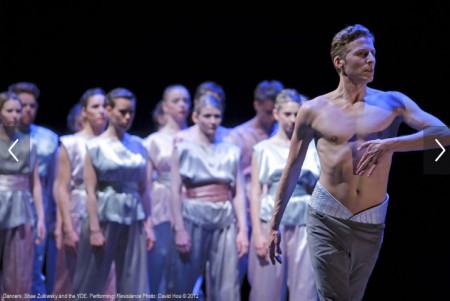by Jacquelyn Thayer
Elegant and agile, few images in skating are more celebrated than that of the ballerina on ice, the dancer on blades.
It’s away from the spotlight that the magic is born — through nine hour training days, frequent commutes or specialized injury. A childhood in the studio cedes to sessions in skates; a youthful career on the ice expands with the barre.
From national medalists to rising choreographers, an education in performance dance increasingly intersects with a career of sport.
Ice dance of all disciplines has a natural reliance on the off-ice dance realm, and for a few skaters such training has formed a vital part of their on-ice presentation. In the case of Canada’s Alexandra Paul, with partner Mitchell Islam a four-time national medalist and 2014 Olympian, a passion for dance on the floor preceded any dancing on ice.
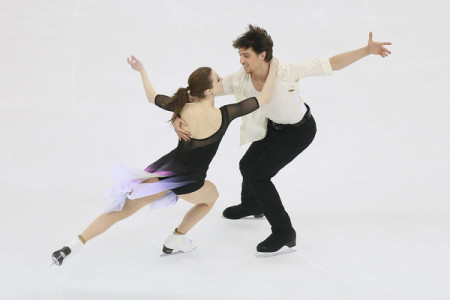
Paul and Islam perform in the free dance at the 2015 World Figure Skating Championships. Photo by Xiaolu Chu/Getty Images Sport.
Paul, now 23, first took on ballet at the age of four, enrolled in classes alongside older sister Katie. Two years later, a shift in focus to singles skating at Barrie’s Mariposa School of Skating would preoccupy her activities — though it was that very emphasis that would return her to the studio at 10. “My singles coach suggested to my mom that I start taking [ballet] up again because it would become useful for the programs that I was doing that year,” Paul said. “And I fell in love with it again.”
At her home studio, Paul embarked on the Royal Academy of Dance syllabus, including pointe work, and by 15 added to her palette with studies in competition dance. “I did jazz, contemporary,” she said. “I took a few years of tap as well, but I wasn’t as interested in that as I was with ballet — ballet was probably my focus and I enjoyed the ballet classes the most.”
Paul’s strengths as a dancer would lead to a new twist in her on-ice career, when early in 2007 she was paired with Jason Cheperdak to form a new ice dance team. Success, including national bronze at the novice and junior levels in 2008 and 2009, suggested some benefit from her background, but also meant a choice for Paul.
“I was having earlier and earlier mornings to get to school on time, and my dance classes were going later and later at night because I was part of the older group,” she said. “So I had to start cutting back on my dance classes when I was about 16 or 17 to be alive in the morning for skating.”
After a split from Cheperdak in early 2009, Paul teamed with Mariposa training mate Islam, himself an ice dancer from the age of 9 with first partner Joanna Lenko. But despite that longer tenure in the discipline, Islam’s own off-ice training in key styles like ballet, ballroom and contemporary began in earnest only in his teen years, serving as support for a growing international career. “I guess I consider myself not the most natural mover,” he said. “I think it’s definitely something that I’ve found beneficial to my skating, something that complements what I do on the ice to a large degree.”
Despite the couple’s different backgrounds, a strong ongoing emphasis on dance off the ice at their training base of the Detroit Skating Club — with instructors including recent addition Veronique Breen, former dancer with the Dutch National Ballet — has been key to their growth together.
“What comes naturally to us is long lines, kind of free movement, having the ability to really skate in a program and let go and just fly across the ice,” said Islam. “You can see it when Alex is dancing, there’s not much that she does that looks bad. Everything she does looks pretty natural and is quite graceful and beautiful, and you can chalk that up as training off the ice in dance.”
If dance is fundamental to an ice dancer’s success, its relationship with skating’s other disciplines — particularly pairs — is more complex. Grace is prized, but elements like jumps and throws demand rather different mechanics than a twizzle or step sequence.
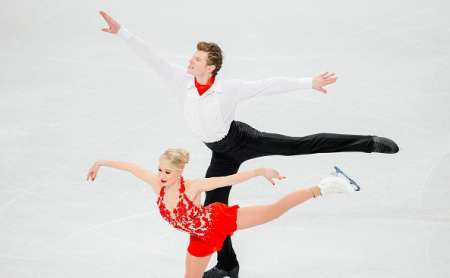
Yankowskas and Gaman perform in the short program at the 2015 European Figure Skating Championships. Photo by Jonathan Nackstrand/AFP/Getty Images.
Still, Caitlin Yankowskas, a national pairs champion for both the U.S. (with John Coughlin) and Great Britain (with Hamish Gaman), credits off-ice experience as her on-ice inspiration. “My parents put me in dance when I was two, so I was a dancer before I was a figure skater,” she said. “I’ve just always loved ballet, and what I loved about skating when I started it was how I could apply what I learned in the dance studio on the ice, and it worked.”
At 14, Yankowskas was accepted into New Hampshire’s Methuen Ballet Ensemble under director Vanessa Roe Voter, where she spent more than three years. “I danced ballet and pointe and did different recitals and The Nutcracker, and I absolutely loved every second of it,” she said. But with a relocation in 2007 to Colorado Springs to train at the elite World Arena, skating won the day. While she pursued ballet school locally in the spring off-season, focus shifted primarily to the on-ice life.
Like Paul, Yankowskas found maintaining two training regimens a balancing act.
“I had absolutely no social life,” she said. “I woke up at 4:30 in the morning and got to the rink at 6:45 and skated from 6:45 until 12 or 1, and then went home and had to do my school because my parents were adamant that I had to be educated. So I had my classes for four hours, and then four or five days a week I would go into the studio to dance for another three hours. And I would go home and study and then go to bed.”
Madeline Aaron, 2014 U.S. junior pairs champion with Max Settlage, similarly found a first love in ballet, donning slippers at three and studying at the School of Ballet Arizona in Phoenix until the age of 12 — logging six appearances in the company’s annual Nutcracker production along the way.
“I came from a very strict Russian ballet training, and the way they teach it, you show up for the whole entire three hours five times a week or you don’t come at all,” she said. Such intensity of focus, along with a daily hour’s commute, was ultimately unsustainable alongside a developing skating career, one which would eventually take her, too, to Colorado Springs.
For new pair and 2015 Challenge Cup champions Gretchen Donlan and Nate Bartholomay, ballet has proven significant for each in a unique way.
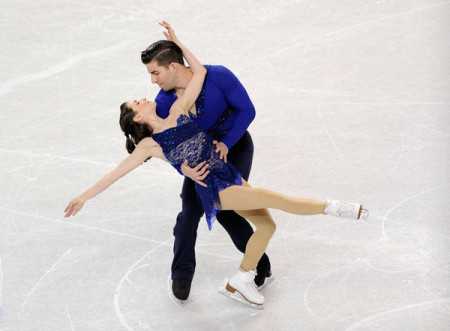
Donlan and Bartholomay perform in the short program at the 2015 U.S. Figure Skating Championships. Photo by Jared C. Tilton/Getty Images North America.
“I was wearing tutus since I was three,” said Donlan. “I always thought I would be a ballerina.”
Pointe shoes, introduced around the age of 10, spelled Donlan’s first turn more heavily towards skating, though she continued regular classwork three times a week into her teen years training in Boston. “I’d do ballet camps very consistently throughout my skating training with a woman who had been a dancer with the Boston Ballet,” she said. “And then when 14 hit, it was hard to keep up my ballet training and skate and train as hard as I wanted to there.”
It was at 14, meanwhile, that Bartholomay began his own ballet education — as support for his development as a pairs skater. “I think it just really helps, especially as a pair guy, [as] our upper bodies are pretty tight,” he said. “We try to stretch out, but you do 50 lifts in a day and stretch out for 20 minutes, it doesn’t really add up. So I think being able to move, and being able to have a good port de bras and have a good line, can hide a lot of sins.”
For some skaters, a serious foundation in dance off the ice has led to its own career. Choreographer Shae Zukiwsky competed in ice dance with Judith Longpré until 2004, making the 2003-04 Canadian national team, while cultivating a life in the dance world — beginning in childhood, he noted with a laugh, with tap lessons. Skating and complementary dance training gradually developed into what he called “a really intense period.”
“I was also completing a Bachelor of Fine Arts degree in Contemporary Dance from Concordia University in Montreal,” he said, “and besides the about four hours of on-ice training I was doing for figure skating, I was also doing up to about six hours of dance training a day at the university.”
A choreographic career, beginning with programs for Canadian singles skater Leah Hepner, developed concurrently, followed by a Master of Fine Arts in Interdisciplinary Studies from Simon Fraser University and, beginning in 2010, pursuit of a Ph.D. in Dance Studies at York University.
With the benefit of time, Zukiwsky identified some lessons to be drawn from the particular intensity of his earlier commitments.
“These were incredibly long days, physical days,” he said, “and looking back, I realize I had to learn how to thoroughly manage my time, but also far more importantly, how to manage my body, like how to stay healthy, how to stay rested, and how to remain inspired on a daily basis in order to continue to develop and to learn.”
Zukiwsky continues his efforts in each arena, creating and directing dance in the studio, choreographing for skaters including 2015 World Junior pairs silver medalists Julianne Séguin and Charlie Bilodeau and 2012 Canadian junior ice dance champions Andréanne Poulin and Marc-André Servant, and serving as an ISU technical specialist in ice dance.
He credits his dance roots for enhancing his understanding of performance and preparation in the skating world.
“I was initially quite a nervous competitive skater, and it was through the skills I acquired as a dancer off the ice that I became a much stronger and more consistent competitor,” he said. “I kind of stopped looking at competition as a competition and just another performance, and this really changed the way that I experienced the competition and actually found enjoyment.”
Dance also inspired his development of a “bodily practice” incorporating meditation, stretching and strengthening to maintain health as a dancer and choreographer. “My dance practice is a huge part of my life — it’s how I choose to live my life, in a way, and the skating and the skills I learned through skating and dancing have really fostered that.”
Maintaining a footing in two athletic worlds, or transitioning between them, places expected demands on energy, endurance and the importance of overall intelligent wellness practices — while introducing certain more unique dangers.
Tackling an advanced level of ballet study has meant balancing the physical demands of pointe work with time passed in skating boots, each creating its own distinct stresses on the foot. Aaron suffered an avulsion fracture requiring surgery after just one year in pointe shoes. Yankowskas recalled weekly podiatrist visits.
“The calluses, the corns, the blisters. I mean, I was losing toenails. It was really gross,” she said with a laugh. “Fortunately I had skates and pointe shoes on, so no one could see my feet, but it was pretty brutal. Every time in the summer I would go to the beach, I would stick my toes into the sand so no one could see them.”
But Paul believes her experience with pointe work actually conferred a special advantage.
“It made my ankles extremely strong which helped a lot in skating,” she said. “Naturally as skaters, our ankles are a little bit weaker because we’re so used to having them in boots, and having the boots helps support our ankles, so I think it was a benefit to me to have done so much pointe work.”
For these skaters, it’s also left a greater physical legacy — for the better and, occasionally, worse. Yankowskas and Aaron each credit the discipline with fostering their awareness of form and posture.
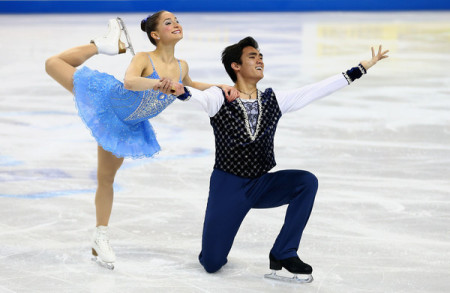
Aaron and Settlage perform in the short program at the 2015 U.S. Figure Skating Championships. Photo by Streeter Lecka/Getty Images North America.
“I think, honestly, my posture has been ingrained in me from all those years of ballet, so it makes for a really easy transition on the ice,” said Aaron. “Everything from turning out and pointing my toes, those kinds of things, seems to come naturally to me.”
Donlan, too, aims to carry the port de bras and toe point to the ice, but has found that certain habits can create unfavorable effects.
“In my jumps sometimes I have a wide free leg and I turn out my hip, and that’s great in ballet to have turned-out hips, but not when you’re doing a triple toe,” she said. “So sometimes I turn out too much, and sometimes my knees don’t bend as much as they should because they’re so pulled up like I’m en pointe in ballet. So I have to be careful about how much to give and how much not to give.”
Her partner, however, values the big-picture benefits for technique in lifts and throws. “I feel like it’s really just taught me how to maintain my flexibility, especially in my upper body, and it kind of teaches me how to move within my own self,” said Bartholomay. “I’m not trying to be something that I’m not, it just has taught me how to hold myself in a way that’s pleasing.”
The training legacy can have its impact on the aesthetic level as well, with both Paul and Aaron crediting it with fostering their preferences towards more balletic program style.
“It’s just the most natural movement for me on the ice,” said Paul. “But again, I did take jazz classes. I did all of the crazy music, shaking around in the little belly tops when you’re 15 years old, I did all that, so it’s not like those kind of movements are foreign to me. I just enjoy the lyrical side better.”
And the impact of one discipline on another can go in both directions, as Zukiwsky discovered in his efforts in the studio.
“I remember performing some [dance] pieces back in my undergraduate days where I would be in moments of stillness and people would always say ‘Wow, even when you’re still, you look like you’re moving through the space,'” he said. “And I think that simply came from all the hours I spent on the ice, where you do have this stillness, but it’s accompanied by this incredible flow and momentum.”
Though formative for most of these skaters, the current role of dance off the ice in training can vary. Both Aaron and Yankowskas note that ballet has not been utilized recently in their respective off-ice regimens, though Yankowskas, currently training in Montreal, relies on her rink’s Essentrics program, which she describes as “a combination between Pilates, yoga and ballet.”
But at the Ellenton Ice Complex, ballet is well emphasized, something Donlan especially appreciates as a change from her days in Boston. “I was so excited that down here in Florida they regularly integrate ballet class at least two times a week in the regimen, so I just am in love with it,” she said. “I’m so happy I’m back.”
The instructor of ballet, meanwhile, may face some culture shock when presented with skaters from a less dance-oriented discipline. At the Detroit Skating Club, Veronique Breen works in the classroom with both ice dancers and freestyle skaters. While skaters with some foundation in ballet bring ingrained positioning skills — what she calls “the ABCs” — those working cold have delivered a bigger challenge.
“Some of them have literally never had any ballet, don’t even know the basic positions, so doing a port de bras or using terminology is totally like I’m speaking a different language to them, which can be quite shocking when you realize what they can do on the ice,” she said. “And you go, ‘How can you present yourself when you don’t even know what first position would be?'”
To properly train both sets of students, Breen has adjusted her own methods, from the working lingo to expectations for turnout and difficulty of exercise — including duration.
“As ballet dancers, we get used to holding our arm in a second position for 64 counts, and we are not going to complain,” she said. “In skating, it is a different mentality. They will be asked by their coach to do one element. They do that element, they skate back to the boards to chat with the coach about the correction that needs to be applied to that. The holding of position and having the stamina to just do basic skills is a little different for them.”
Indeed, skaters in both disciplines point to certain lessons best learned off the ice. Aaron prizes the study she obtained in the classroom, where “you have to learn to move to the beat of the music and those little fine-tuned things are easier to pay attention to when you’re not on the ice.”
“On the ice, skating can come very easily to a lot of us, where we’ve trained every day for a big portion of our lives,” said Islam. “But a lot of the movement and a lot of the isolation dancing is a little more foreign, especially to someone like me, so I think it’s very important, as an ice dancer, to keep trying to expand your horizons when it comes to personal movement and your ability to dance.”
Education and inspiration alike may also come in the form of watching other dancers. Toronto-born Paul particularly admires some of the leading lights from the National Ballet of Canada.
“Heather Ogden and Guillaume Côté — they’re so amazing at what they do,” she said. “They feel the music, they’re amazing choreographers, and they’re good at all styles of a dance — they can play anything from a harsh character to the angelic dancer. It’s amazing to see the variation that they can portray on the stage.”
“One of my ultimate favorite dancers right now is Sarah Lamb because she’s from Boston, like me, and now she’s dancing in London with the Royal Ballet, so I kind of think of her as a muse because I feel like she’s the ballet version of me,” said Yankowskas with a laugh. She also cites the Boston Ballet’s retired Larissa Ponomarenko and Alina Somova of the Mariinsky among other favorites.
Donlan, while a fan of her hometown Boston Ballet and the Sarasota Ballet of her new environs, is especially drawn to the Russian tradition, with a recorded performance of The Firebird from one company especially prized. “I just love the great toe point and ease with all the attitudes — just how easy and perfect it looks and just knowing that it’s so hard,” she said.
And Islam noted the inspiration he’s taken from performance dance shows like Burn the Floor and STOMP.
“You really appreciate how seriously these professionals take performing,” he said. “That’s something that we definitely need to focus on as skaters, because that’s what really takes you to the next level. If you want to keep climbing the world rankings, you really have to make sure you’re performing and bringing audiences in.”
As choreographer and dancer, Zukiwsky has been inspired by major figures in the contemporary and modern dance world, most notably Pina Bausch. “[Her] work taught me how to look at dance differently and to experience movement in a completely different manner,” he said, “a much more corporal, emotional and experiential way of experiencing the movement” — a departure from a stricter narrative approach.
Certain qualities overall, more than a given figure or company, can also impress. Both Paul and Islam admire the “strong dancer,” someone who can command an audience amid technical mastery. Yankowskas pays special heed to line and point.
“It starts from your hands and however you hold your hands, the line travels up to your elbows, to your shoulders, to your neck and it’s how you hold your head,” she said. “It’s really all about what this dancer can portray, like if she or he is playing a role, are they being true to the character and to themselves, and I love to see if they can do that. And I really think it’s all about being authentic.”
In the end, Zukiwsky sees common ground between those doing battle in each realm.
“I’m in constant admiration of their bravery to pursue such a challenging line of work, because these dancers and these skaters who really are choosing to commit to this lifestyle are choosing to follow their dream and in a very committed and rigorous daily practice,” he said. “I think that’s very admirable, because in doing that, there are so many challenges that are presented and these individuals need to really overcome them if they want to continue to pursue what they love.”

